Turku 作者: 来源: 发布时间:2021-04-21
一、所属省或是州,具体位置,人口,面积
Turku is a city on the southwest coast of Finland at the mouth of the Aura River,in the region of Finland Proper (Varsinais-Suomi). The region was originally called Suomi (Finland), which later became the name for the whole country.
It is unknown when Turku gained city rights. The Pope first mentioned the town Aboa in his Bulla in 1229 and the year is now used as the foundation year of the city.
As the oldest town in the country Turku was the most important city in Finland, a status it retained for hundreds of years throughout the centuries under the rule of the Kingdom of Sweden. After the war Finland became an autonomous grand duchy of the Russian Empire (1809) under the direct rule of the Czar and the capital of the autonomous Grand Duchy of Finland was moved to Helsinki (1812).
It was only after the last great fire in 1827 that most governmental institutions were moved to Helsinki along with the Academy of Turku (Turun Akatemia) founded in 1640, which then became the University of Helsinki.
Turku continued to be the most populous city in Finland until the end of the 1840s, and it remains the regional capital and an important business and cultural center and port.
Because of its long history, it has been the site of many important events, and has extensively influenced Finnish history. The history of the country is closely linked to Turku, the former capital.
Along with Tallinn, the capital city of Estonia, Turku was designated the European Capital of Culture for 2011. In 1996, it was declared the official Christmas City of Finland.
Due to its location, Turku is a notable commercial and passenger seaport with over three million passengers traveling through the Port of Turku each year to Stockholm and Mariehamn.
As of 30 September 2018, the population of Turku was 191,499 making it the sixth largest city in Finland.There were 330,192 inhabitants living in the Turku sub-region, ranking it as the third largest urban area in Finland after the Greater Helsinki area and Tampere sub-region. The city is officially bilingual as 5.2 percent of its population identify Swedish as a mother-tongue.
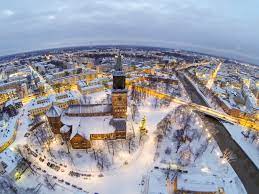
二、自然地理
1.地理条件
Located at the mouth of the Aura river in the southwestern corner of Finland, Turku covers an area of 245 square kilometers (95 sq mi) of land, spread over both banks of the river. The eastern side, where the Turku Cathedral is located, is popularly referred to as täl pual jokke ("this side of the river"), while the western side is referred to as tois pual jokke ("the other side of the river"). The city center is located close to the river mouth, on both sides of the river, though development has recently been expanding westward.
There are ten bridges over the Aura river in Turku. The oldest of the current bridges is Auransilta, which was constructed in 1904. The newest bridge is Kirjastosilta ('library bridge'), a pedestrian-only bridge built in 2013. The Föri, a small ferry that transports pedestrians and bicycles across the river without payment, is a well known feature of the city.
With a population of approximately 300,000, the Turku Region (LAU 1) is the third largest urban region in Finland, after Greater Helsinki and the area around Tampere. The region includes, in addition to the city itself the following municipalities: Askainen, Kaarina, Lemu, Lieto, Masku, Merimasku, Mynämäki, Naantali, Nousiainen, Paimio, Piikkiö, Raisio, Rusko, Rymättylä, Sauvo, Vahto, and Velkua.
A more exclusive definition for the urban area is the city region of Turku with a population around 235,000 consisting of four major municipalities Kaarina, Raisio, Naantali, and Turku.
2. 交通情况
For a city of its size, Turku has a moderate public transport network of bus routes, which is comparable to the bus network of similar-sized Tampere. The bus network is managed and supervised by the Turku City Region’s Public Transport Committee (FÖLI) (Finnish: Turun kaupunkiseudun joukkoliikennelautakunta, Swedish: kollektivtrafiknämnden för Åbo stadsregion), and is operated mainly by private companies. Bus traffic to and in the neighbouring municipalities of Kaarina, Lieto, Naantali, Raisio and Rusko are also handled by FÖLI. The bus rates are the same when traveling within these municipalities.[34]
Rail traffic to and from Turku is handled by the Finnish national carrier, VR. The number of services has fallen and only the railways towards Tampere and Helsinki are now in use. The railway stations currently used for passenger traffic are the Turku Central railway station in Pohjola, and two smaller stations in Kupittaa and the Port of Turku.
There is no local rail traffic at the moment, as the city's popular tram services were discontinued in 1972, and the various local railway lines to neighbouring towns and municipalities were all abolished during the late 20th century. However, there are plans for a light rail system in the Turku region in the near future. This system would more ably serve major suburbs of the city such as Varissuo and Runosmäki, as well as the neighbouring cities.
The State of Finland has announced plans to support Espoo with 30% of full expenses on a new metro rail, the Regional Council of Southwest Finland is going to use this as a test case for a new light rail network in Turku.
The Turku Bus Station and the Turku Central railway station are currently located in different places. The City of Turku is planning to combine these two in a new greater station complex in the near future. This new travel center will consist of a hotel and several shopping estates. This center will connect all public transportation from commuter trains to long-distance buses.
Turku Airport is located 8 kilometres (5 miles) to the north of the city centre, partly in the neighbouring municipality of Rusko. The airport is served by six passenger airlines, including airBaltic and SAS Scandinavian, and one cargo airline.
There are also daily ferry services from the Port of Turku to Sweden and the Åland Islands, operated by Silja Line and Viking Line. These are something of a Finnish cultural tradition (see ruotsinlaiva), and people often travel long distances across Finland to Turku just to take a cruise across the Gulf of Bothnia.
The Archipelago Sea boat traffic is handled by, among others, SS Ukkopekka, an old steamship that cruises on the route Turku-Naantali-Turku.
Turku is the only city in Finland to have three long-distance railway stations: Turku Central, Port of Turku, and Kupittaa.
三、经济发展和规模
The business district in the city's economy is centred on the Port of Turku and other service-oriented industries. The city is also a renowned high tech centre – the Turku Science Park area in Kupittaa hosts over 300 companies[citation needed] from the fields of biotechnology and information technology, as well as several institutions of higher learning that work in closely with the business sector. This cooperative element is seen as a particularly important factor with regards to the city's expected future economic development, as outlined in the Turku Strategy that is published annually by the city council.[citation needed] At least the following major Finnish companies have their corporate headquarters in Turku: HKScan and Hesburger. Other major companies which have operations in Turku include Bayer, Fläkt Woods, Meyer Werft, Orion Corporation and Wärtsilä.
As of June 2015, over 280,000 people were registered as being without employment in Finland. This put June's numbers at 10.0 percent of the population, 0.8 percentage points higher than June 2014. Men's unemployment rate was 10.5 percent and women's 9.4 percent.
四、产业特点重点项目
Turku Business Region is the most dynamic cluster of business and innovation activities in Finland. The 22,000 companies, six universities, and an extensive co-operation network of different players in the region speed up the generation of new products and services as well as growth of business operations and local well-being.
The expanding and increasingly international Turku Science Park, the cluster of maritime and manufacturing industry Blue Industry Park being built near the Turku shipyard, the experience and event center planned in the Turku railway yard, and Turku’s new vision for the city-center give a boost for the future of the Turku region on the whole.
The strong growth is supported by the versatile supply of plots and commercial premises. Ready and zoned space for business operation is available within excellent connections, less than half an hour drive away from an international airport and ports.
The connections in the Turku region also work nationally, and the region has a key role in the developing Stockholm–Turku–Helsinki–St. Petersburg axis.
五、风景名胜,景点( attractions)
1. Turku Castle
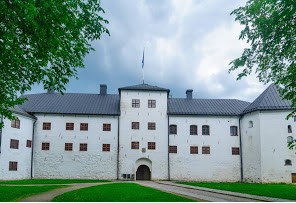
Turku Castle is a medieval building in the city of Turku in Finland. Together with Turku Cathedral, the castle is one of the oldest buildings still in use and the largest surviving medieval building in Finland. It was founded in the late 13th century and stands on the banks of the Aura River. The castle served as a bastion and administrative centre in Eastland, as Finland was known during its time as a province of Sweden. Only once did the castle figure in the defence of the realm, when Russian invaders from Novgorod destroyed Turku in 1318. It more frequently played a role in internal struggles for power within Sweden and the Kalmar Union. The castle's heyday was in the mid-16th century during the reign of Duke John of Finland and Catherine Jagellon. That was when the Renaissance Floor and King's and Queen's hall were built, along with other features. It lost its status as an administrative centre in the 17th century after Per Brahe's period as governor-general of Finland came to an end. Turku castle is today Finland's most visited museum, with attendance reaching 200,000 in some years. In addition, many of the larger rooms are used for municipal functions.
2. Luostarinmäki Handicrafts Museum
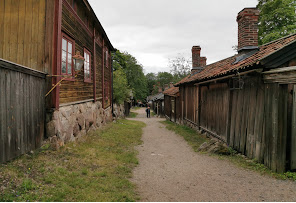
Luostarinmäki Handicrafts Museum is an open-air museum in Turku, Finland. This area of Cloister Hill was developed relatively late for pre-fire Åbo, from around 1775, after another fire. It was decided that the previously undeveloped, although not uninhabited, area to the south of Vartiovuori Hill would be developed as residential accommodation.
3. Kurjenrahka National Park
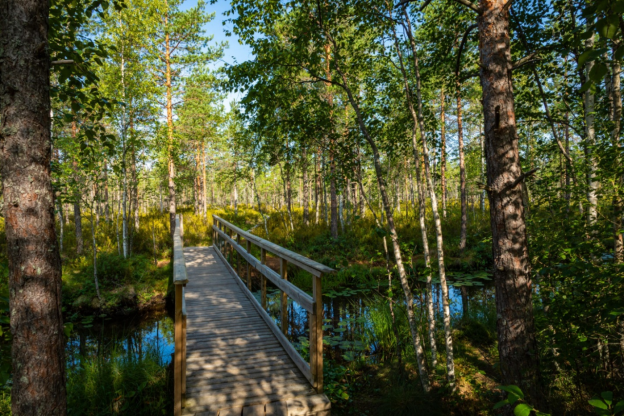
Kurjenrahka National Park is a national park in Southwest Finland. It was established in 1998 and covers 29 square kilometres. The area consists mainly of bog but also includes primeval forests, some of which have been unmanaged for over 150 years. The Eurasian lynx is a permanent resident of Kurjenrahka, but brown bears and gray wolves have also been observed and are known to reside in areas within or close to the park. Marked trails in the general area extend to over 300 km. In Middle Ages the forests were jointly owned by the local parish. In early 1800s two manors bought them, but they had financially hard times and had to sell them to the state before end of the 19th century. Before selling, they logged clear all areas with easy access, but some islands in middle of mires remained unlogged.
六、历史文化
1.历史
Turku has a long history as Finland's largest city and occasionally as the administrative center of the country, but for the last two hundred years has been surpassed by Helsinki. The city's identity stems from its status as the oldest city in Finland and the country's first capital. Originally, the word "Finland" referred only to the area around Turku (hence the title, "Finland Proper" for the region).
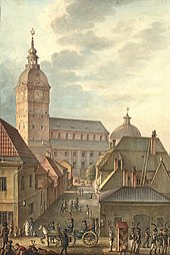
Turku Cathedral, 1814, prior to the Great Fire in 1827
Although archaeological findings in the area date back to the Stone Age and early literary sources such as Al-Idrisi's world map from 1154 mentions Turku, the town of Turku was officially founded in late 13th century.Turku Cathedral was consecrated in 1300.
During the Middle Ages, Turku was the seat of the Bishop of Turku (a title later upgraded to Archbishop of Turku), covering then the eastern half of the Kingdom of Sweden (most of the present-day Finland) until the 17th century. Even if Turku had no official capital status, both the short-lived institutions of Dukes and Governors-General of Finland usually had their Finnish residences there. In the aftermath of the War against Sigismund, the town was the site of the Åbo Bloodbath. In 1640, the first university in Finland, the Royal Academy of Turku, was founded in Turku. Turku was also the meeting place for the States of Finland in 1676.
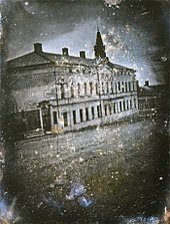
A daguerreotype photograph of the Nobel House, the first photograph taken in Finland, from 1842
After the Finnish War, which ended when Sweden ceded Finland to Imperial Russia at the Treaty of Fredrikshamn in 1809, Turku became briefly the official capital, but soon lost the status to Helsinki, as Emperor Alexander I felt that Turku was too far from Russia and too aligned with Sweden to serve as the capital of the Grand Duchy of Finland.[citation needed] The change officially took place in 1812. The government offices that remained in Turku were finally moved to the new capital after the Great Fire of Turku, which almost completely destroyed the city in 1827. After the fire, a new and safer city plan was drawn up by German architect Carl Ludvig Engel, who had also designed the new capital, Helsinki. Turku remained the largest city in Finland for another twenty years.
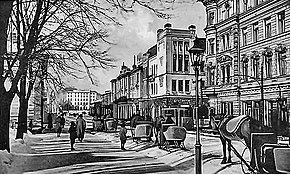
Aurakatu area in the 1910s
In 1918, a new university, the Åbo Akademi – the only Swedish language university in Finland – was founded in Turku. Two years later, the Finnish language University of Turku was founded alongside it. These two universities are the second and third to be founded in Finland, both by private donations.
In the 20th century, Turku was called "Finland's gateway to the West" by historians such as Jarmo Virmavirta. The city enjoyed good connections with other Western European countries and cities, especially since the 1940s with Stockholm across the Gulf of Bothnia. In the 1960s, Turku became the first Western city to sign a twinning agreement with Leningrad in the Soviet Union, leading to greater inter-cultural exchange and providing a new meaning to the city's 'gateway' function. After the fall of Communism in Russia, many prominent Soviets came to Turku to study Western business practices, among them Vladimir Putin, then Leningrad's deputy mayor.
As for architecture in the city, both the body of architectural styles as well as the prevalent way of living have experienced significant changes in the 20th century. While having survived relatively intact throughout the years of war 1939–1945[citation needed], the city faced increasing changes in the 1950s and 1960s due to rising demands for apartments, the eagerness to rebuild, and most of all the new development of infrastructure (especially increased automobile traffic). The wooden one- to two-story houses that were the dominant mode of building in the city were mostly demolished in the 1950s and 1960s to both enable more efficient building and to ease vehicle traffic. This resulted in the destruction of buildings that were, in later decades, seen as beautiful and worth saving. Some individual buildings remain controversial to this day when it comes to their demolition in the decades after the war. For example, the building of Hotel Phoenix that stood on corner of the Market Square was torn down to make way for a large, multistory apartment building in 1959. The building was significant both for its location and history: having stood on one of the most valuable lots in the city center since 1878, the building had, for example, served as the first main building of the University of Turku. Other buildings whose demolition was seen as scandalous, either already at the time of action or proved to be so in later years, include The Nobel House (subject to the very first photograph ever taken in Finland) and the building of Old Hotel Börs which was built in jugendstil in 1909 by Frithiof Strandell.
2. 文化
Cultural venues in Turku include several theatres, cinemas, and art galleries, and a city philharmonic orchestra. The city's cultural centre organises a number of regular events, most notably the Medieval Market in July each year. Turku is also the official Christmas city of Finland, and 'Christmas Peace' in Finland is declared on every 24 December from the Brinkkala Hall balcony. The Turku music festival and the rock festival Ruisrock (held on the island of Ruissalo) are among the oldest of its kind in Scandinavia. The city also hosts another rock festival, Down by the Laituri, and one of the largest electronic music festivals in Northern Europe, UMF (Uuden Musiikin Festivaali, "New Music Festival"), in addition to a vibrant nightlife, centred on the Market Square.
There are also numerous museums, such as the Turku Art Museum and the Wäinö Aaltonen Museum of Art. The Åbo Akademi University maintains the Sibelius Museum, which is the only museum in Finland specialising in the field of music. Apart from these, there are also several historical museums that display the city's medieval period, such as the Turku Castle, which has been a functional historical museum since 1881, and the Aboa Vetus museum, built in the late 1990s over the 14th century archaeological site. The Luostarinmäki handicrafts museum, converted from residential buildings that survived the Great Fire of Turku in 1827, was the first Scandinavian venue to receive the "Golden Apple" tourism award.
The Declaration of Christmas Peace has been a tradition in Finland from the Middle Ages every year, except in 1939 due to the Winter War. The declaration takes place on the Old Great Square of Turku, Finland's official 'Christmas City', at noon on Christmas Eve. The declaration ceremony begins with the hymn Jumala ompi linnamme (Martin Luther's Ein feste Burg ist unser Gott) and continues with the Declaration of Christmas Peace read from a parchment roll in Finnish and Swedish.
七、其他信息
Turku is European Capital of Culture in 2011, and the city council has approved numerous projects to boost the city's image in preparation for that status.
The Turku region offers a strong foundation for business and innovation activities. The success is based on industrious entrepreneurs but also long-term co-operation between different actors. The determined and persevering work of the universities and municipalities in the region for the local spearhead fields has supported the rise of the Turku region into the engine of Finland’s economic growth. The key factors of success are top research, growth-seeking and networked companies, as well as business-friendly municipalities and cities that are actively looking for new operating models.
八、联系方式
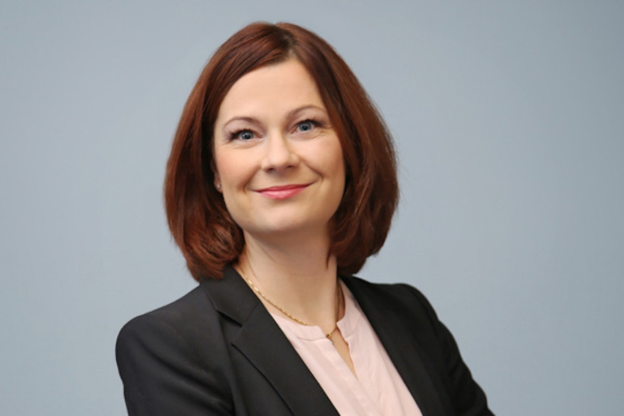
Mayor of Turku: Minna Arve
Address: Aurakatu 2, 20100 Turku
Phone: +358 2 262 7444
Wesite: info(at)visitturku.fi
Email: info(at)visitturku.fi
